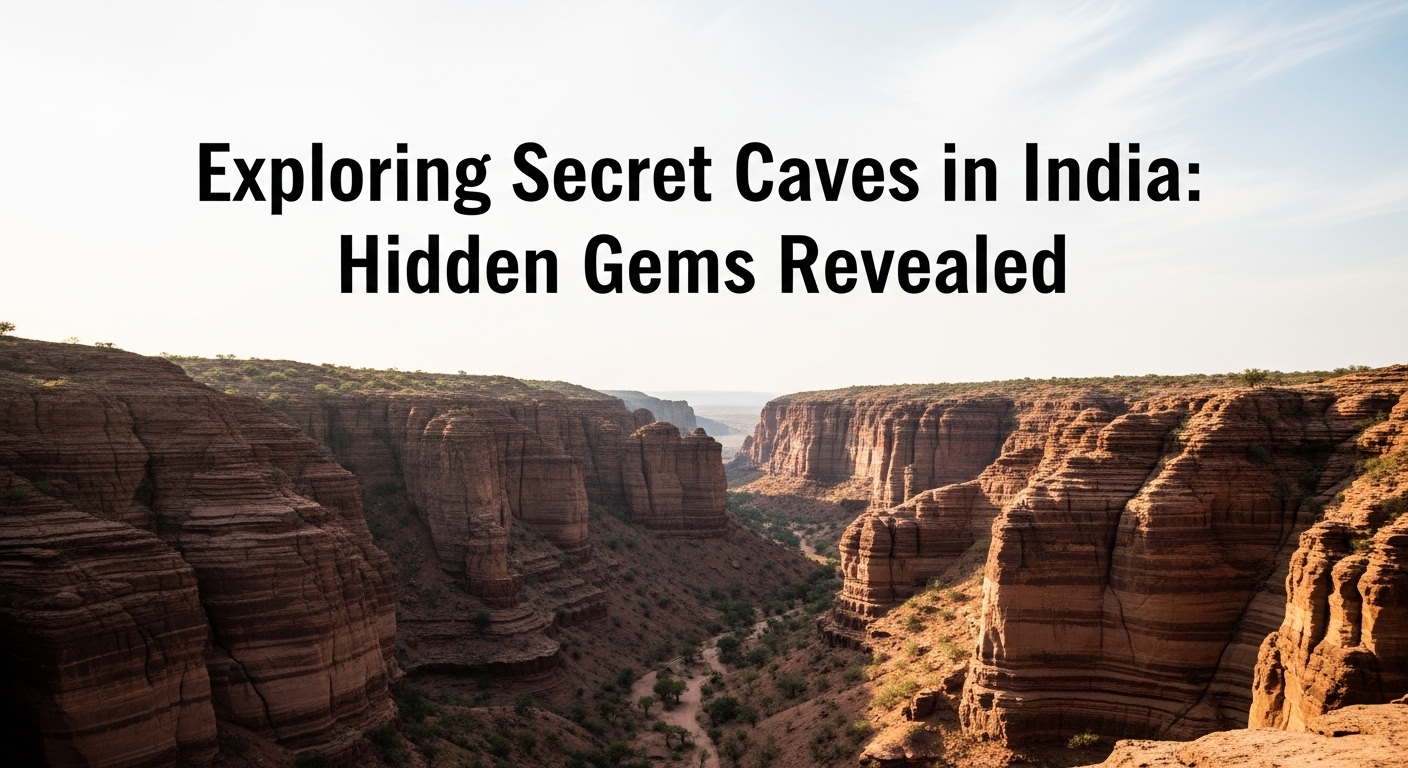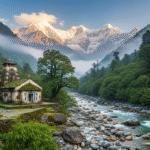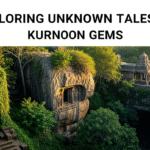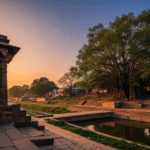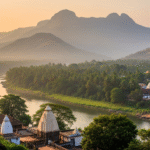Meghalaya, India, has the world’s longest sandstone cave. It is 24.5 kilometers long. This shows how India’s secret caves hide amazing natural and historic wonders.
Hidden caves in India are filled with beauty and history. Adventurers can see incredible sights underground. From ancient temples with beautiful art to caverns full of special plants and animals. Exploring places like Krem Puri in Meghalaya or the Ajanta and Ellora caves is exciting. Each place has its own unique story.
Key Takeaways
- Krem Puri in Meghalaya is the world’s longest sandstone cave, measuring 24.5 kilometers.
- Meghalaya boasts the highest concentration of caves in India, with over 1,650 discovered.
- Ajanta and Ellora caves in Maharashtra are historical marvels dating back to ancient times.
- The Badami Caves in Karnataka showcase intricate sculptures of Hindu and Jain deities.
- Borra Caves in Vishakhapatnam delight visitors with stunning stalactite and stalagmite formations.
The Mystical Krem Puri Cave in Meghalaya
The Krem Puri Cave lies in the lush hills of Meghalaya. It’s the world’s longest sandstone cave at 24.5 km. Known as the “Cave Fairy,” it offers a peek into a hidden underground world. It’s surrounded by beautiful nature.
Geological Significance
The cave tells us a lot about the area’s history. It’s all sandstone, which is quite rare. This makes it a key spot for learning about Earth’s past. Finds like shark teeth teach us about changes over time.
Challenges in Exploration
Exploring Krem Puri is tough. It’s full of twisty passages that challenge even brave explorers. The area’s thick forests and heavy rains add to the difficulty. Yet, with expert guides, visitors can safely see its wonders.
Danger rises during the monsoon. Water levels go up, making the caves risky. Narrow, slippery paths become more dangerous. But, with care, it’s still an amazing place to explore.
Unique Fauna and Flora
Krem Puri has unique life forms. Creatures like giant spiders and bats call it home. This makes it important for science, not just as a cave, but as a living habitat. Its plants and animals show how life adapts in hidden places.
| Cave Name | Length (km) | Exploration Difficulty |
|---|---|---|
| Krem Puri | 24.5 | Challenging |
| Krem Liat Prah | 34 | Moderate |
| Other Caves in Meghalaya | Up to 31 | Varied |
Ancient Wonders: Ajanta and Ellora Caves in Maharashtra
The Ajanta and Ellora caves in Maharashtra show off ancient Indian architecture. They give us a peek into India’s deep history and culture. These caves have amazing sculptures, detailed murals, and buildings full of religious meaning. They share stories of faith and art skills from the past centuries.
Historical Background
The Ajanta caves were made starting in the 2nd century BCE. They are important to the history of Buddhism in India. These 30 caves were created in two stages—first in the 2nd century BCE and then around 400–650 AD. The Ellora caves, built between the 5th and 10th centuries, mix Hindu, Buddhist, and Jain beliefs. They are close to each other, only 96 kilometers apart. This makes it easy for visitors to see both Ajanta and Ellora in one day. This is why they are precious pieces of ancient cave art.
Architectural Marvels
Ajanta is famous for its well-kept frescoes that tell about the life of Buddha and Jataka tales. These paintings are full of stories about kindness and finding enlightenment. Ellora, on the other hand, has 34 monasteries and temples. The Hindu caves there show different types of art from the 6th to the 8th centuries. Ellora’s biggest highlight is the Kailasa temple. It’s the largest single rock-cut temple in the world. It looks like Mount Kailash and shows amazing architectural skills.
Religious Importance
The cave arts in Ajanta and Ellora show the religious spirit of their makers. Ajanta’s murals are very important to Buddhism. They celebrate what Lord Buddha taught. Ellora’s caves have big shrines for Hindu gods and detailed Jain art. You can see things like the pillars of Indrasabha and sculptures of Yakshini and Durga. The Grishneshwar Temple is also close by. It’s one of the twelve Jyotirlingas dedicated to Lord Shiva. This highlights the area’s spiritual significance.
https://www.youtube.com/watch?v=vmQP69exo1o
| Feature | Ajanta Caves | Ellora Caves |
|---|---|---|
| Time Period | 2nd century BCE to 650 AD | 5th to 10th century |
| Total Number of Caves | 30 | 34 |
| Main Religion | Buddhism | Hinduism, Buddhism, Jainism |
| Notable Structure | Fresco Paintings | Kailasa Temple |
| Key Nearby Temple | N/A | Grishneshwar Temple |
Bhimbetka Caves: A Glimpse into Prehistoric Art
The Bhimbetka Caves lie in Madhya Pradesh’s green lands. They show some of the first art by humans. Their walls have colorful drawings that tell us about early people’s lives and beliefs.
Rock Paintings and Inscriptions
The Bhimbetka cave artworks are from different times, like the Old Stone Age. They show social events, like dancing and hunting. These paintings help us understand early humans. The caves have over 760 rock shelters. Nearly 500 have ancient art in green and yellow. They show how early people lived.
UNESCO World Heritage Site
In 1957, Dr. Vishnu Wakankar found the Bhimbetka Caves by chance. UNESCO named them a World Heritage Site. This honor shows how important they are for learning about our past.
Archaeological Discoveries
The caves have given us many old finds. Some art is around 30,000 years old. These are among the oldest drawings found anywhere. Scientists also found old tools and pottery. This helps us know more about early humans. Guided tours of these caves offer a close look at their art.
Secret caves in India: The Enigmatic Belum Caves of Andhra Pradesh
The Belum Caves are in Andhra Pradesh, India. They are among India’s biggest natural underground wonders. With a length of 3,229 meters, they are India’s second-longest caves. They captivate with beautiful rock shapes and secret paths.
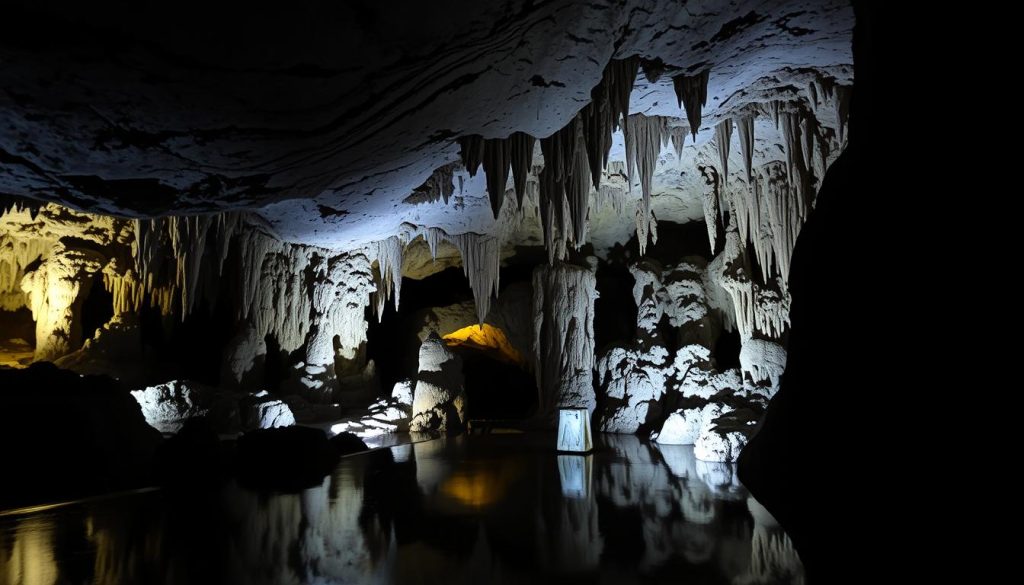
Formation and Structure
The Belum Caves show amazing geology. They have cool stalactites, stalagmites, and winding tunnels made by the Chithravati River. These shapes are stunning, created over thousands of years.
Historical Significance
The Belum Caves are famous not just for their looks but also their history. People found ancient stuff here that shows old civilizations lived here around 4,500 BC. They found old pots and Buddhist things, showing Neanderthals might have been here. A big 40-foot Buddha statue stands at the entrance.
Unique Natural Spectacles
At the Belum Caves, you can see cool spots like the Meditation Hall and Thousand Hoods. There’s also a Musical Chamber and the amazing Banyan Tree shape. These spots show the variety in this big cave system. It’s best to go with a guide to learn all the secrets and history.
The Ministry of Tourism and Culture in India noticed the Belum Caves in 2003. They see it as a great place for tourists to visit. Every year, lots of visitors come. To learn more about these great Andhra Pradesh caves, and get tips on travel and places to stay, look more into it.
Natural Splendor: Borra Caves in Vishakhapatnam
Borra Caves sit in the Anantagiri Hills of Araku Valley. They are a natural wonder of Vishakhapatnam. These caves have beautiful rock shapes formed over many years. William King George discovered them in 1807. People from all over come to see them.
Formation of Stalactites and Stalagmites
The Borra Caves geology shows unique rock formations. Some are named after myths like Shiva-Parvathi. They are 705 meters up and lit up to show their beauty. Tourists love these caves. Bats live here too, making the caves more interesting.
Local Beliefs and Legends
The cave lore and legends of Borra Caves are vital to local tribes. A cowherd found them and a Shiva Lingam inside. This spot is not just pretty but also sacred. Eco-tourism helps locals keep their traditions and welcome guests.
| Borra Caves Vishakhapatnam Entry Fee | Price |
|---|---|
| Adults | ₹60 per person |
| Children | ₹45 per person |
| Phone Camera | ₹25 |
| Digital / Still Camera | ₹100 |
| Video Camera | ₹100 |
| Borra Caves Vishakhapatnam Operating Hours | |
| Monday to Sunday | 10:00 am – 5:00 pm |
Ambiguity and Adventure: Exploring Badami Caves in Karnataka
The Badami Caves in Karnataka are a wonder. They show the amazing Indian rock-cut architecture from red sandstone architecture. These famous caves have four main caves. Each one is special, honoring different Indian gods and beliefs. They give us a peek into India’s rich religious and art history from the 6th century A.D.
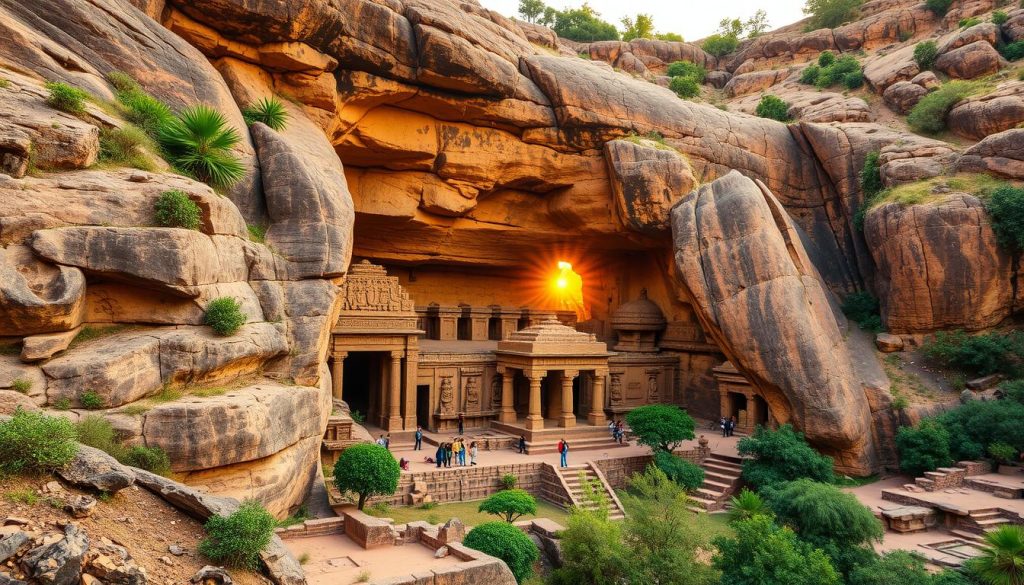
The Badami Caves were made by the Chalukya dynasty. They showed their architectural skills here. They ruled near the Malaprabha river, in North Karnataka. This was during the time of Pulakesin II, who grew their land a lot. The landmarks they left, like Aihole and Pattadakal, show their love for building amazing rock-cut places.
Visiting these Karnataka caves shows how Buddhism influenced them. It mixes northern and southern temple styles. The findings in Aihole and Pattadakal go back to the Satavahanas. They started the temple-building tradition in this area.
The Badami Caves stand out for their amazing sculptures and writings. These offer rare clues on how the Chalukyan architects and builders worked. Even if we don’t know all about how they were built, these old caves still draw in those who love adventure and history.
The Karnataka caves are not just beautiful. They are important for their spiritual value too. Temples like Virupaksha and Sangameshwara at Pattadakal are still worshiped in.
Badami is a key spot for those exploring the Chalukya dynasty’s big works. It’s close to famous places like Hampi and Pattadakal’s World Heritage sites. This makes Badami a must-visit for those on a journey to discover history and spirituality.
To really get the greatness and history of the Badami Caves, you need to see them for yourself. Walking through these Indian rock-cut architecture wonders, you dive into a story of faith, skills, and art that has lasted for many centuries.
Marble Marvels: Elephanta Caves in Mumbai
Take a short ferry from Mumbai to see the Elephanta Caves. They show off India’s rich art through rock temples and sculptures.
These amazing caves date back to the 5th century and are a UNESCO site. They let us see Indian cave art skill. Look at the huge three-headed Shiva sculpture and other works. The carvings tell stories of Hindu myths, thrilling art lovers and historians.
The Elephanta Cave tour lasts 4 to 6 hours. Places like Magical Mumbai Tours offer it. They have made over 100k travelers happy. The tours give you history with local experts. They make sure you’re comfy with AC rides, water, and guides.
You also get to explore the lively local market. Shopping there makes your visit last about 8 hours. This mix of culture and shopping is why you must see the Elephanta Caves in Mumbai.
The Elephanta Caves, carved out of marble and dating back to the 5th century, display the artistic and cultural greatness of ancient India.
Tours focus on your safety and convenience. They usually run on Tuesdays and Sundays from 8:00 AM. This makes planning easy for everyone.
If you love old architecture, myths, or just exploring Mumbai’s caves, the Elephanta Caves are a must-see. They take you on an amazing journey through history and art.
Undiscovered Depths: Caves of Bodh Gaya
The Bodh Gaya caves, especially the Dungeshwari caves, show Buddha’s spiritual journey. Close to Bodh Gaya, these caves in Bihar are peaceful and full of devotion. Many think Buddha meditated deeply here, making the caves spiritually important.
These caves have many statues and relics. They show important parts of Buddha’s life. This art from long ago also tells us about religious history. The quiet Dungeshwari caves are a key place for those wanting to feel Buddha’s teachings.
People visit these caves for many reasons. Historians and archaeologists love them for their history and how they have stayed in good shape. The caves show how Buddha’s early followers worked hard to keep his memory alive.
- Statues and Relics: Numerous artifacts depicting Buddha’s life.
- Spiritual Relevance: Significant site for Buddhist meditation and devotion.
- Historical Importance: Historical caves in Bihar with rich cultural heritage.
The Bodh Gaya caves, including the famous Dungeshwari caves, mean a lot for those on a spiritual journey. They are not just about religion. They also bring a sense of lasting peace to everyone who visits.
Conclusion
Exploring Indian caves is like stepping back into history. These caves, from the ancient Ajanta and Ellora to Krem Puri and Belum, show nature and humanity working together. They reveal stories from 6000 BC and display centuries of art and architecture.
India’s caves each have something special. The Ajanta Caves show how art changed from 200 BC to 658 AD. Ellora Caves show India’s cave architecture. Nashik Caves have amazing water systems. And the Elephanta Caves have beautiful sculptures. Each cave shows great skill and thought.
The Barabar Caves are among India’s oldest. They show early cave building skills. The Kailash temple at Ellora is also amazing. These places are so important they’re even in the UPSC IAS Exam. Over 2 lakh students learn about them. They show how ancient caves help us understand India’s past. These caves are like museums. They keep the story of incredible India alive.
FAQ
What is the longest sandstone cave in the world?
The Krem Puri Cave holds this title. It is in Meghalaya, India’s lush hills.
What makes the Ajanta and Ellora Caves in Maharashtra significant?
These caves are known for their old Indian architecture. They are filled with religious symbols. They connect to Buddhism, Hinduism, and Jainism over centuries.
Why are the Bhimbetka Caves important in prehistoric studies?
The Bhimbetka Caves show us ancient rock paintings. They are a peek into our prehistoric days. This site is a UNESCO World Heritage Site, with old artifacts.
What are some unique features of the Belum Caves in Andhra Pradesh?
The Belum Caves are famous for their natural beauty. They have stalactites, stalagmites, and sinkholes. They show signs of Neanderthal life, with old relics found.
What geological phenomena can be observed in the Borra Caves of Vishakhapatnam?
The Borra Caves showcase amazing stalactite and stalagmite formations. They have spiritual legends. They are loved for their natural beauty.
What is the historical importance of the Badami Caves in Karnataka?
The Badami Caves are known for their ancient art and devotion. They have rock-cut architecture from the 6th century. They honor Hinduism and Jainism.
What can visitors expect to see in the Elephanta Caves of Mumbai?
In the Elephanta Caves, visitors see amazing rock temples. They include a giant statue of Lord Shiva.
Why are the Dungeshwari Caves near Bodh Gaya historically important?
The Dungeshwari Caves are where Buddha is believed to have meditated. This makes them very important. They have statues honoring Buddha.
What challenges do explorers face in the Krem Puri Cave?
In Krem Puri, explorers navigate through tricky passages. The cave’s shape is changed by forests and rainfall. This makes exploring tough.
How does spelunking in India offer a unique experience?
Spelunking in India is special for many reasons. It mixes natural beauty with history and culture. India’s caves offer adventures and discoveries.
